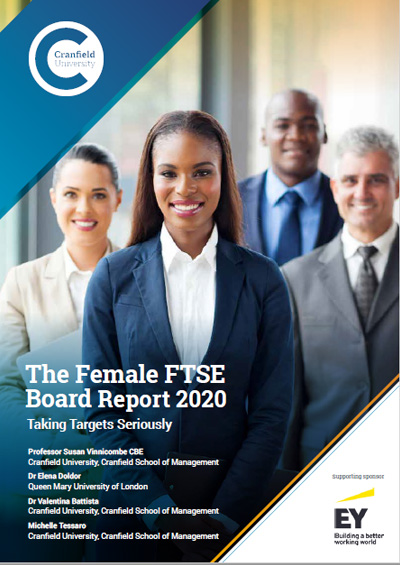- New research finds lack of women in senior board roles and in senior executive roles – there are only five female CEOs in the FTSE 100
-
Organisations need to address long-term effects of COVID-19 on women’s careers
- Targets can improve gender balance and unroot bias, but greater accountability is needed by UK boards to accelerate progress on diversity
Voluntary targets have boosted gender diversity on UK boards, but new research by Cranfield University’s School of Management warns that there are still too few women in senior leadership positions, such as CEO and Chair, to drive long-term change.
The annual Female FTSE Board Report, sponsored this year by EY, finds that although the FTSE 350 looks on track to reach the target of 33% of women on boards by December 2020[i], a lack of representation at the top could be impacting the number of women in the executive pipeline.
Women need to be in influential roles
The most notable increase in female representation is among Non-Executive Director (NED) roles. In the FTSE 100 the percentage of female NEDs is at an all-time high of 40.8% (38.9% in 2019), while the percentage of female executives has risen only slightly to 13.2% (10.9% in 2019).
Sue Vinnicombe, Professor of Women and Leadership at Cranfield University, and lead author of the report, said: “This year our research establishes that it is not sufficient just to have a critical mass of women Non-Executive Directors on a board in order to increase the number of women in the executive pipeline. There need to be women in influential roles such as Executive Directors. The added dimension of COVID-19 means organisations must be proactive to address the long-term impact of the pandemic on women’s careers. With more focus on flexible working and wellbeing, it is an opportunity to progress the diversity agenda.”
Targets can unroot bias and enable meritocracy
The Female FTSE Board Report found that targets are now established as normal business practice, with those set by the Davies and Hampton-Alexander Reviews driving internally-set targets in organisations.
Elena Doldor, Reader in Organisational Behaviour at Queen Mary University of London, and report co-author, said: “Targets don’t threaten meritocracy, they enable it. Our research indicates that when used ambitiously and systemically, targets can unroot bias across key talent management processes and contribute to genuine culture change. For targets to become more robust, it is critical that organisations put in place accountability mechanisms for their meeting their targets and address the long-term impact of the pandemic on women’s careers.”
Female FTSE Board Report findings
The report, which focused on the 12 months up to the 1 June 2020, found:
- FTSE 100: the percentage of women on boards has increased from 32% to 34.5%, with 324 women holding 355 directorships. The percentage of female Non-Executive Directors (NEDs) is at an all-time high of 40.8%, and the percentage of female Executives has risen slightly to 13.2%.
- FTSE 250: The percentage of female Directors has risen from 27.3% to 31.9%, The percentage of female NEDs is 37.6%, but the percentage of female Executive Directors (EDs) is low at 11.3%.
- There continue to be few women appointed to senior roles; there are still only five women CEOs, eight women Chairs and 21 women Senior Independent Directors in the FTSE 100.
- The number of FTSE 100 committees has risen from 295 in 2019 to 393, however the percentage of women chairing these has dropped from 31% to 29%.
Do targets work?
In this year’s report, the research team investigated how targets are being used in practice.
- Most of the organisations adopted voluntary targets because previous diversity initiatives had failed.
- There had been little resistance to targets and gender targets have become relatively normalised in the UK.
- Despite a general emphasis on realistic targets, more ambitious targets were sometimes seen as a way of mobilising organisations into action, even when they are not fully met. The trend was a target of 30%-40% women in senior leadership roles.
- Targets are a tool for culture change. When implemented thoroughly and ambitiously, targets created scrutiny and unrooted bias across key talent management processes.
- Organisations do need to address more proactively the long-term effects of the current pandemic on the pipeline of female talent by taking tangible actions to buffer the disproportionate impact the lockdown has had on women’s careers.
Alison Kay, EY UK&I Managing Partner for Client Service, said: “There is no doubt that targets have helped to improve diversity on UK boards, by setting a clear vision and keeping organisations on track. However, as outlined in the report, targets must be coupled with action on cultural change to accelerate progress for future generations and spark a positive ripple effect that extends into the wider economy and society.”
The Women to Watch supplement to the Female FTSE Board Report is also published today and highlights 100 inspiring senior women business leaders who are ideally suited to board positions on FTSE 350 companies now or in the near future.
The Female FTSE Board Report is produced annually by Cranfield University’s School of Management, which has been monitoring trends in women’s representation on FTSE 350 boards since 1998. The 2020 report authors are Professor Sue Vinnicombe CBE, Dr Elena Doldor, Reader in Organisational Behaviour at Queen Mary University of London, Dr Valentina Battista, Lecturer in Human Resource Management, Cranfield University and Michelle Tessaro, Doctoral Researcher at Cranfield University.
Notes for editors
[i] Target set by the Hampton-Alexander reviewInformation for the report was downloaded from BoardEx on 1 June 2020.







